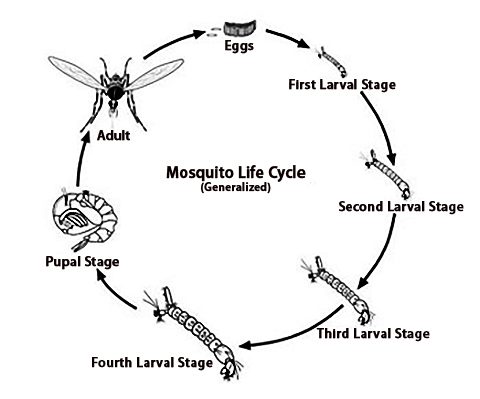The Mosquito Life Cycle
There are 37 species of mosquitoes in Pinellas County. Each species has a habitat they are adapted to, such as floodwater, swamps or man-made containers. Some can tolerate salt water, while others are only in freshwater. Some mosquitoes are specialized and bite only birds, amphibians or mammals, while others will bite many kinds of animals. Though the habitat and hosts vary, every mosquito needs water to complete its life cycle.
Mosquitoes go through a life cycle called complete metamorphosis — the same life cycle as beetles, butterflies, moths and other insects. How long it takes depends on the temperature. Hotter temperatures will speed up their life cycle, while colder temperatures will slow it down.
During our summer, it can take as little as a week to go from egg to adult, and frequent rainfall provides plenty of places mosquitoes can breed. During our winter, lower temperatures slow the life cycle to a month, and less frequent rainfall reduces places mosquitoes can breed.

Life Cycle Stages
There are four stages in the mosquito life cycle:
- Egg – Some mosquitoes lay eggs directly in water while others lay on the edge of containers or in moist areas that frequently flood. All mosquito eggs need water to hatch.
- Larva (larvae) – All mosquito larvae need to live in water. Larvae go through four stages, called instars, and eat plankton, fungi, bacteria and algae.
- Pupa (pupae) – All mosquito pupae need to live in water. Pupae do not feed at all. Unlike the pupae of other insects, like moths and butterflies, mosquitoes are still highly mobile at this stage and actively swim.
- Adult – All adult mosquitoes feed on nectar as a food source. Only females bite, and different species feed on different types of animals. Females use the protein from blood to make eggs. Females can become infected with pathogens and arboviruses (viruses that can be spread to people through a bite) during bloodmeals. Once the infection reaches their salivary glands (about 2 weeks later), they can spread them through their bite. Adults are the only stage that can become infected and spread arboviruses and pathogens.